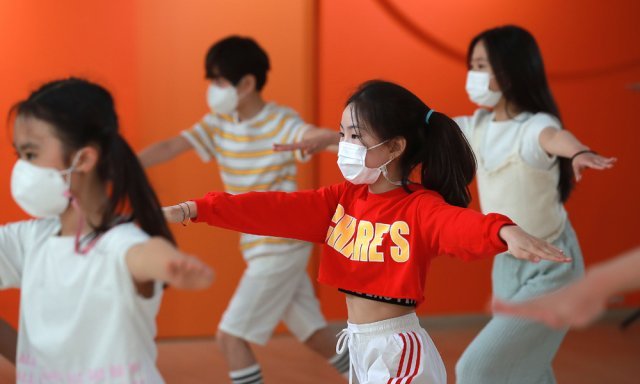
Girl group Aespa‘s ’Next Level‘ began to play through the speakers. One by one, children who were chitchatting on the floor stood up. It’s time to put the neon colored cube puzzle and smartphones bigger than the palm of their hands, back into the schoolbag.
“Five, six, seven, eight”

The scene above depicts a typical ’Basic routine‘ class in SL studio, a K-pop academy located in Shinsa-dong, Gangnam-gu, Seoul. The youngest student is in second grade and the eldest is in sixth grade of elementary school. They are already well versed in most idol dance choreography, not to mention the latest dance moves of songs flowing from the speaker. In spite of this, they continued to repeat the simple stretching movements of arms and legs with serious looking eyes even though it seemed as though they’ve done it hundreds of times.


The basic routines are followed by a cool down exercise comprised of planks (3 sets of 40 seconds), burpees (15 reps) and leg stretching. Students too young (2nd~4th graders) who don‘t have enough physical strength are exempt from such exercise. Sitting in a row on stair seating at the back of the practice room, they observed what the older kids were up to, wiggling their legs that don’t reach the ground.
On evaluation day at month-end, individual feedback on the progress the students have made, from extension of the arms and legs, waves to turning movements are updated in a KakaoTalk group chat where all the parents are invited.
‘Keep the unused arm still, there’s more strength in the arms but they‘re too slow and need to extend further back, legs need to be firmer’, ‘torso should not tilt forward when coming back up’, ‘the hands are held too close to the body’….
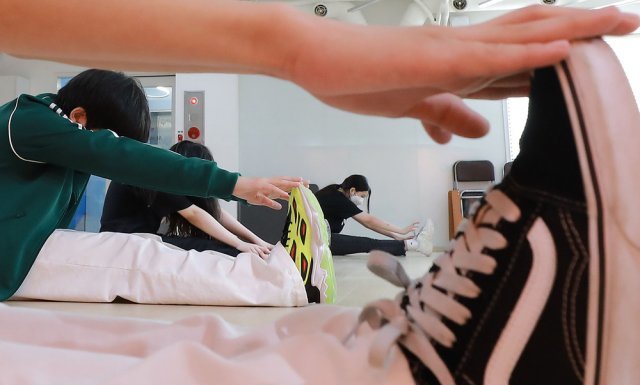
Park Jimin, now a 6th grader in elementary school, is one of those kids, though he‘s still too young to be accustomed to getting on buses and subways by himself. One rainy spring day on May 16th, Jimin and his mom left their house located in Eunpyeong-gu, Seoul. Since November 2019, Jimin’s regular weekend routine as well as during weekdays involves going to SL Studio for practice.
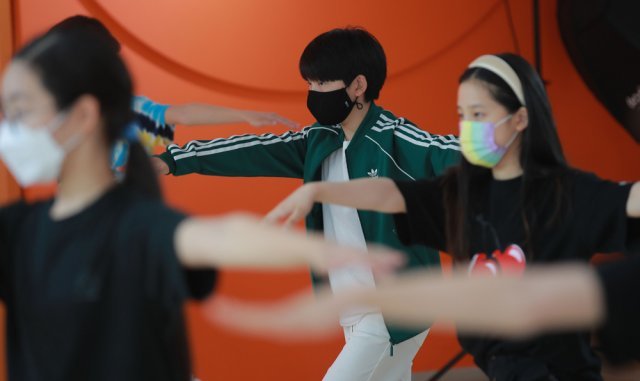
Upon arrival, Jimin went straight to the lobby on the second floor and wrote his name ‘Jimin’ on a reservation table to book a practice room. Due to limited space, the academy students have to fill in their names in the table at 50 minutes past every hour in order to reserve a room they can practice in. When the time comes each hour, students form a long line in front of the reservation table - especially on weekends due to back-to-back lessons and students visiting from remote cities. The sofa seats at the back are fully occupied by moms waiting for their kids‘ lessons to be over.
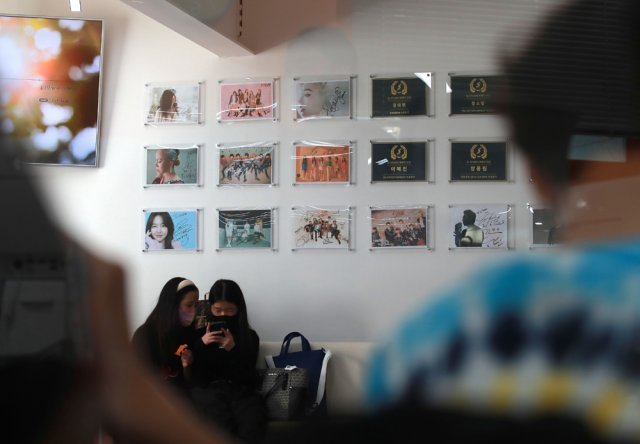
On the wall of the lobby, there is ’the hall of fame‘. A series of nameplates show the names of former students who were cast as trainees and the name of the Company that scouted them. Such installations evoke a similar image of those found in prep schools for universities, displaying the universities that students were admitted to.
Photos and autographs of Taeyeon of Girls’ Generation, Kai of Exo, Moonbyul of Mamamoo and other top celebrities who are former students of Lee Sollim, the head of SL Studio, are also exhibited on the wall. Adults who visit the studio for the first time curiously take a close look. The academy students who aspire to become K-pop idols, however, don‘t pay much attention to such memorabilia on the wall. For those who were born when songs like ’Gee(2009)‘, ’Genie(2010)‘ by Girls’ Generation, and ‘Growl(2013)’ by Exo were sweeping the K-pop music scene, the celebrities on the wall aren‘t really the best source for inspiration.

On Sundays Jimin devotes his time to practicing on his own, as he has no lessons to attend. After endlessly repeating the arm and leg extension he learned in the basic routine class, he went on to practice Shinee’s ‘Don’t call me‘ choreography, the latest dance song he learned. At 2:50 pm he moved to the vocal practice room where he intensively and repeatedly practiced two songs for two hours. Yoon Soyeon, Jimin’s mom, said she is used to such routine practices now, since joining her son on this journey nearly two years ago. “It‘s not like he’s practicing to please parents or family, he‘s aiming for perfection. That’s why it takes time,” she said.
At 4:50 pm, Jimin booked the dance practice room again to work on his dance moves for an upcoming audition. The loud music from the speakers muted the vibration from the smart watch he‘d taken off at one corner of the room. The smart watch also functioned as a phone for Jimin, who doesn’t have one, and the screen showed that a ‘Peppermint candy’ was calling him. Peppermint candy was a friend‘s nickname who lived downstairs. He had called Jimin just moments ago to see if he was available to go out and play. Just before hanging up, Jimin said ’he couldn‘t because he was at a hagwon(private institute)’. The friend unbendingly kept calling him to say, “how can you pick up if you are at hagwon, you must be kidding”.

Recently, Jimin went to his first ever audition. At auditions open to younger children like Jimin, the entertainment agency staffs focus more on the potential of audition participants rather than the skills they have right now. Another challenge for them is to predict how the young idol hopefuls will look like in the near future based on their present appearance of a small kid. That‘s why the staffs sometimes ask the height of the participants’ family members and take photos of their faces with an open forehead.
Lee, who‘s been uncovering to-be idol stars for the past 18 years at the academy, commented on a recent trend in which much younger children are showing up for auditions these days.
“In the past, entertainment companies were reluctant to have elementary school children at auditions, so they’d say things like ‘please come back in three months’. When kids become official trainees, the company gets involved in their social media use or school life; that‘s why companies prefer older kids, like second or third grade of middle school. These days however, even fifth or sixth graders in elementary school get scouted as trainees. Some companies have even set an age limit, saying that they will only allow participants aged ’16 years or younger‘ to their auditions, so children tend to start preparing early on.”
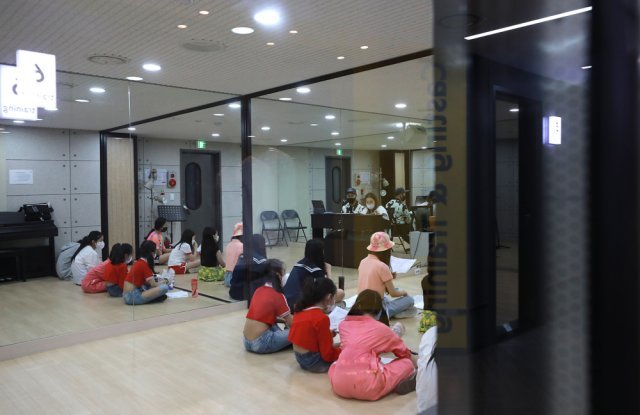
Another emerging trend is the diversity of trainees’ nationalities. Aspiring idols from countries like Taiwan, Japan, China, and Thailand visit the academy to be appraised by a Korean entertainment company. “People say Korea is now a powerhouse thanks to BTS. In a similar vein, there‘s growing recognition overseas that if you want to become an idol, ’you have to be trained in Korea‘” Lee added.
Just like any entertainment company, the academy also has evaluation sessions at the end of each month to gear up its students for upcoming auditions. For their debut to even be able to be called a dream, they first have to become official trainees at a company. The barriers are extremely high though, so high that it’s not an overstatement to say that becoming a trainee is a dream in itself.
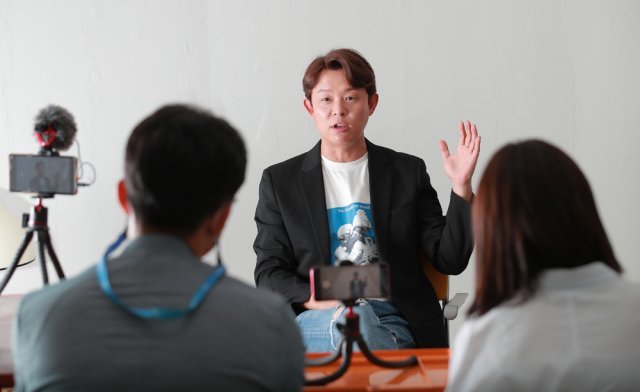

Admittedly, the road to ultimate success is narrow. Even if one makes the debut after rigorous training, it all takes place in a world where it‘s more ’realistic‘ to see rookie idol groups disappear without a trace after some time. Against all odds however, countless children throw their heart and soul to reach the ’unrealistic‘ world.
Tony Ahn, a former member of ’H.O.T.‘, the group referred to as the origin of K-pop idols and now a joint representative of a K-pop academy (Stage 631), shared the concerns he has when he stands before children who dream of becoming idols at special lectures, in terms of how straightforward he has to be about the reality.

“I have to tell them about what goes on in the real world, but I understand that it’s hard to fully grasp unless they experience it for themselves. Knowing their dreams are inspired by the objectives and ideals they have autonomously set for themselves, I don‘t think that I have the right to make them give up their dreams. So I tell the kids that the rewards they reap when they achieve their dreams come with hardships commensurate with such perks, and that when we weigh the perks and the pain, they are exactly 50:50. The children already know what it’s like to be under heavy pressure with the month-end evaluations and occasional presentations they have to go through. Constant pressure and stress will be something they have to live with, so if they can withstand such challenges, embrace such pain and turn them into happiness, I tell them it may be the right path for them.”
If he could turn back time to when he was in elementary school right before he auditioned at SM Entertainment, Tony Ahn said that he would still ‘go for it’. He believed that taking on new challenges may mean facing one‘s own limits, but it is up to each individual to either break through those limits or find an alternative path; and perhaps one can find a fast track to learning life lessons amidst such intense competition.
“Looking at kids rising to the challenge makes me realize why Korea became the top destination for cultivating idols. Who could have thought that Korea or even anyone from Asia for that matter, could conquer the world by dancing and singing? Many people ask me ’how the Korean music industry will evolve after BTS‘, and I can see a glimpse of the future in these children. The bottom line is that the entertainment industry is clearly well organized and systemized - though it’s probably not intended to be like that. Unless there are unexpected twists, I think Hallyu(Korean wave) as we know it will continue for some time to come.”

Jimin, born in 2009, doesn‘t know what H.O.T or who Tony Ahn is. Instead, he grew up watching BTS blast to the top of the Billboard charts; when asked why he wishes to become an idol he replies, ’because I want to be the best in the world‘. Yoon, Jimin’s mom, says although she would be worried how hard it would be on her son if the training period was prolonged, she believes that everything‘s okay for now.
“The best thing would be for Jimin to realize his dream after all the hardships he endured, but there are disproportionately more people who also try their best, endure all the sufferings and yet still don’t make it. Rather than saying ‘this is all you’ve got. There is no other way‘, I think it’s important to have a more flexible mindset and say ‘you are doing this because it’s what you love doing now, but it may not be your only path forward. You could always try out new things based on what you‘ve learned so far. Moreover, the very experience of passionately engaging in something is what’s truly valuable.‘ I say this because I believe that some things in life, you can only experience at a certain age.”
Jimin’s older sister had also trained to become an idol, but as she went on to high school she decided to focus on her studies. She independently made up her mind after confronting what lies ahead, and realized that she had little chance of making the debut as an idol. Likewise, no one knows what the future holds for Jimin, for now.
An evening routine for Jimin is to write a poem about the practice he‘d done for the day. It also helps him get better at writing lyrics, a skill he might need one day. Even before he could cool down from all the sweat after practice, Jimin picked up a pencil. He wrote a short poem comprised of seven lines that captures the flood of flashlights he got from reporters that day.
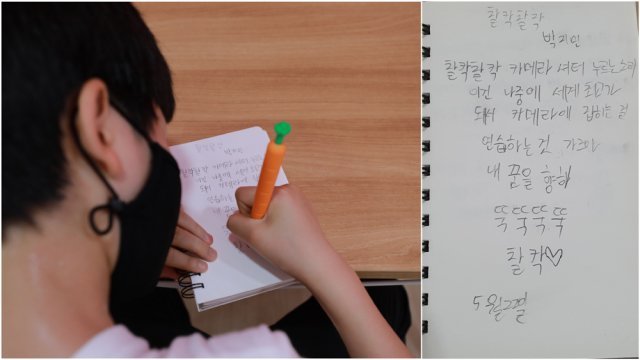
Snap snap
Snap snap, the shutter sound of the camera
A rehearsal for the future
To stand before the camera
As the best artist in the world
Pursue my dream
Go go go go
Snap
May 22nd
Donga Hero contents team
-
- 좋아요
- 0개
-
- 슬퍼요
- 0개
-
- 화나요
- 0개
-
- 추천해요
- 개
지금 뜨는 뉴스
-

돌이킬 수 없었던 뇌 손상… 줄기세포로 되돌린다
- 좋아요 개
- 코멘트 개
-

中커머스 어린이 신발 장식품서 기준치의 348배 발암물질 검출
- 좋아요 개
- 코멘트 개
-

美 1분기 성장률 1.6%, 시장 전망 크게 하회… “스태그플레이션 조짐”
- 좋아요 개
- 코멘트 개
댓글 0